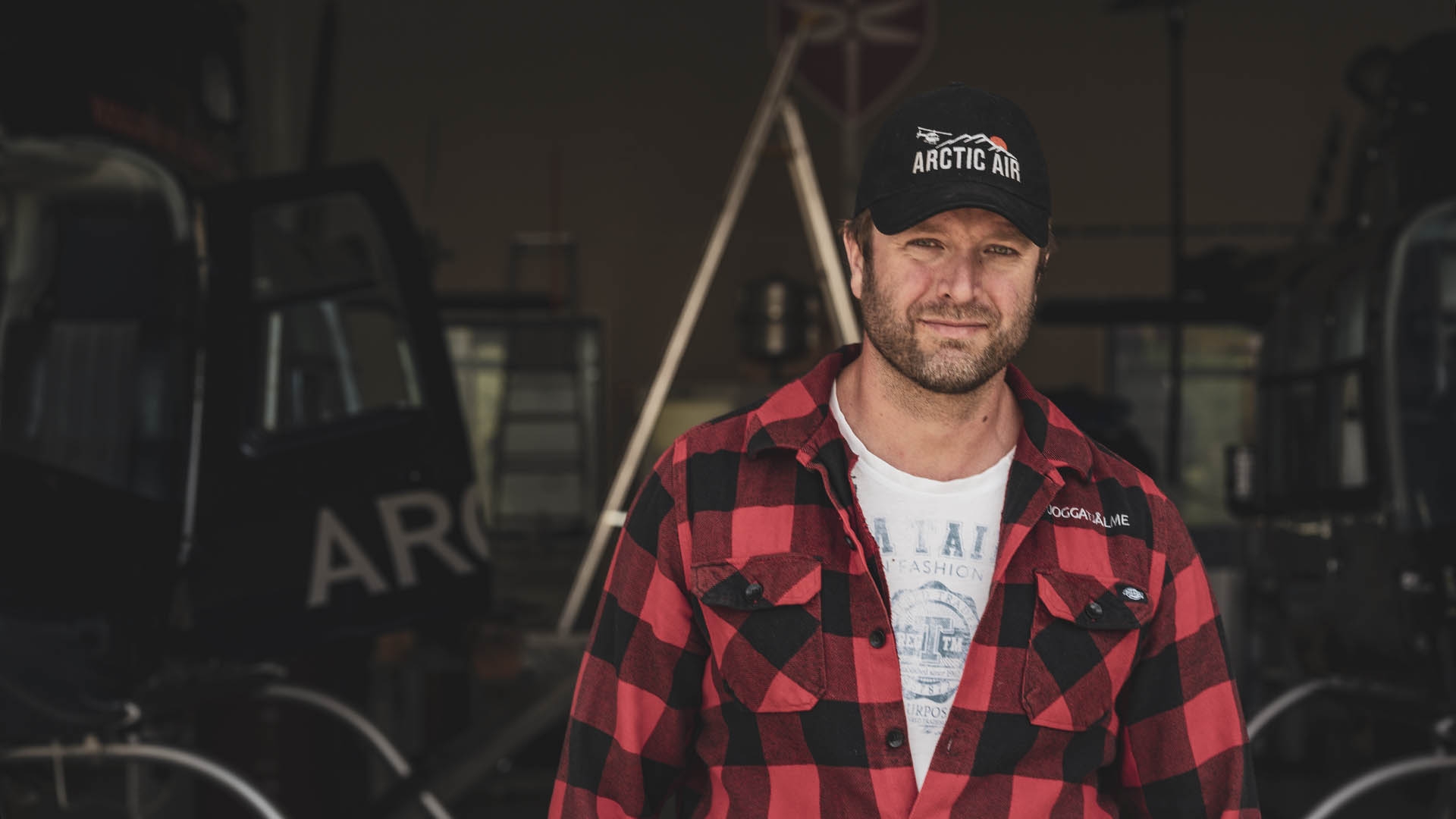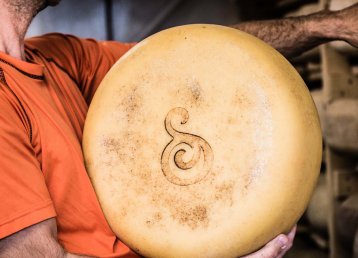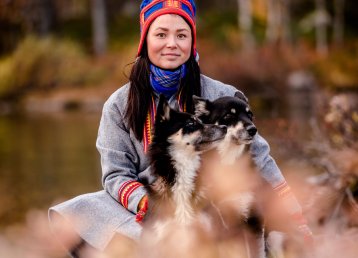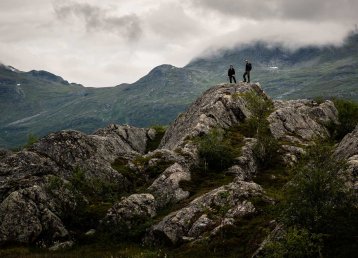They say homesickness is a primordial force. Many of us have at some point along the way suddenly found ourselves longing for home, and one of our oldest stories is about the prodigal son who returns home. When Björn Helamb in Vuoggatjålme was eleven years old, he went to school in Jäckvik, 60 kilometres away. He desperately wanted to go home.
— I wasn’t bullied. I lived with amazing people, and I did well at school, but still: I was homesick!
One day in spring it was decided that the class would go on a school trip to Luleå, and Björn asked his teacher if he might be allowed to go home instead. He was. The night before the rest of the class would head down to the coast, Björn took the school bus in the opposite direction. He went west to Sädvaluspen, where the road ended. From Sädvaluspen, 11-year-old Björn was going to walk the last 30 kilometres home. It was the end of May, and the snow was melting rapidly. Happy as can be, Björn headed homewards, along a very rudimentarily cleared path.
A will to get home
Vuoggatjålme was still roadless land at the time, and the gravel road did not make its appearance on the Helamb family homestead until 1975, but the phone lines were in place. When Björn had walked 10 kilometres, to Ballastviken, he was meant to stay the night. But as he arrived in Ballastviken he still felt strong, so he called home and asked if he could continue to the next stop in Lillviken, which is what he did.
— It was early spring (slush and snowmelt) and I remember that when I came to the stream that empties into the bay in Ballastviken, the meltwater was high. The spring flood sprayed wildly all over the bridge, so the only way to get across to the other side was to crawl along the bridge railing. I’ve never forgotten how the railing and the bridge vibrated from the water pressure.
— God yes, says Björn’s wife Monika as she hears the story again, if you’d fallen in there it would have been game over.
— If I’d fallen in there, no one would ever have found me, says Björn.
Stories by the kitchen table
We are sitting in Björn and Monika’s home in Vuoggatjålme. Art hangs on the walls, adding to the history of this place. The scent of coffee and homemade cinnamon buns is in the air. The ragdoll cat Sambo lies in one of the armchairs, supremely relaxed. It certainly is difficult to understand how an 11-year-old walked 30 kilometres in roadless land, but things were just different back then. There is something serious about mountain pilot Björn Helamb, and at the same time something gives the impression that he is never far from a good story and a hearty laugh. Perhaps that is what happens if you grow up in roadless land, if your dad dies way too soon, if you have flown helicopters in the mountains since 1975. You learn what is real, and what is a good story.
"There is something serious about mountain pilot Björn Helamb, and at the same time something gives the impression that he is never far from a good story and a hearty laugh."
Björn’s mum Mimmi was in charge of the farm Vuoggatjålme for a long time, offering half board to those who stayed there and lived with the family. Her life seems to have been a beautiful – but certainly hard and laborious – adventure. She moved away from Vuoggatjålme when she found love in the shape of artist Kalle Hedberg. They lived in Copenhagen and Stockholm, but after a few years Mimmi moved back home. Art and artists have always been important in Vuoggatjålme. Near the Silver Museum in Arjeplog there is a Sami hut that Bengt Lindström has painted. It is called the Mimmi Hut and is a tribute to Mimmi from Vuoggatjålme and her way of looking after the artists. Bengt created the hut shortly after Mimmi had suffered a stroke. He picked her up in a wheelchair for the inauguration, and they toasted with champagne.
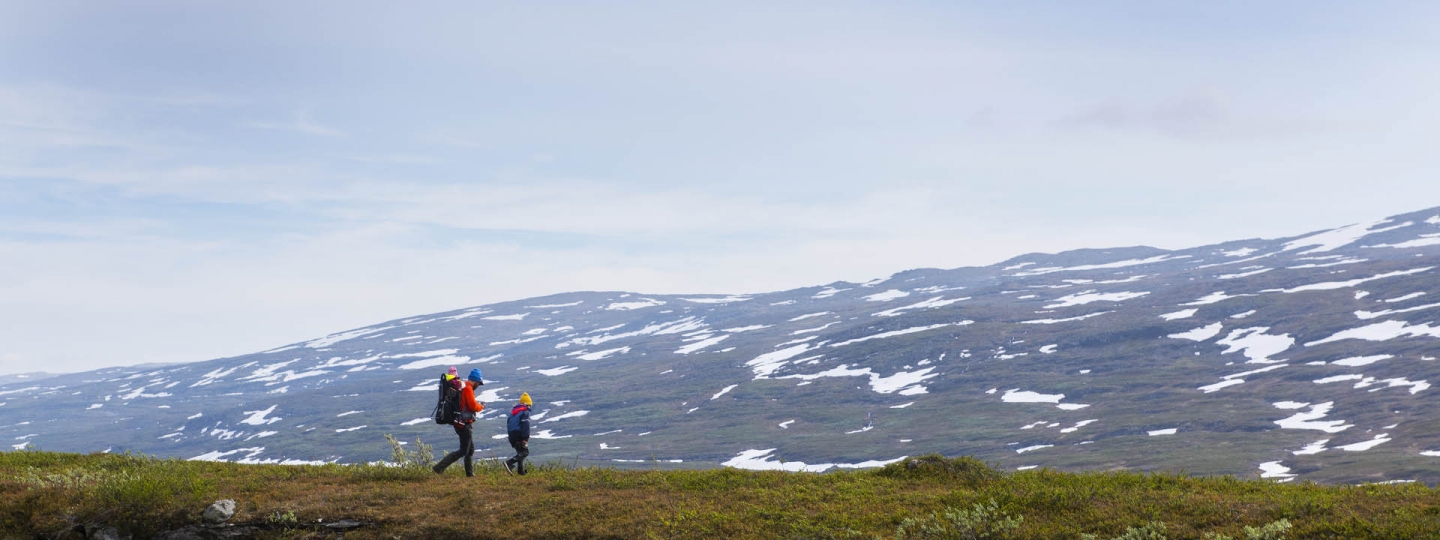
Easy living
Vuoggatjålme is a perfect getaway in the Swedish mountains. Easy to access and great service making it a treat for the outdoor family.
A dream of a telephone
Mimmi Helamb was born and raised at the mountain homestead Riebnes. It was 25 kilometres to the nearest neighbour, rowing down the lake in summer, or skiing on the ice in winter. But when a lease – the right to use someone else’s land – was offered in Vuoggatjålme in 1922, Frans Abrahamsson, Mimmi’s father and Björn’s grandfather, did not hesitate. He submitted an offer saying he was interested in running Vuoggatjålme, and it was accepted. All of a sudden Frans Abrahamsson, with his wife and seven children, had two farms in a roadless land to take care of. Not to mention the fact that it was 30 kilometres, as the helicopter flies, between the farms. Mimmi has told many stories about this in interviews for radio and in books, about how the family in Riebnes packed things up and trudged off to the new place: Vuoggatjålme. Somehow the family could sense that the future was over there. They would be proven right: Vuoggatjålme got a telephone, a road, and guests, whereas the homestead in Riebnes was flooded by the power plant company. Nothing but the foundation of their old house in Riebnes can be seen these days, and only when the water level in the lake is low. Mimmi Helamb moved back and forth between the farms a number of times, but in 1923 the family made up their minds and moved cows, sheep, goats and chickens across the mountain. The chickens were stuffed into rucksacks for safekeeping and even lay eggs in there – eggs to be fried over an open fire when the going got tough and the family needed ‘minutes’.
The power of homesickness
Homesickness. Grandmother Mimmi moved back home, leaving the artist collectives in Copenhagen, and dad Björn walked home from school through spring slush. I ask Frans Helamb – the fourth generation on the farm, and the one who runs it these days together with his family – about homesickness one morning as he pulls the helicopter out of the hangar.
— My sister did move. But as for me, I’ve barely left the farm, he says and laughs out loud.
That is not quite the whole truth, of course. Frans went to school in Arjeplog and then on to university. But after four years, when there was one semester left of his teacher training, that was it. He had had enough of city life and moved back home. He started working on the farm, in the restaurant, at the campsite, at the same time as he got his certificate as a helicopter pilot and started a family.
— It isn’t an easy choice. It never is. Both Tina and I were nearly finished with our training when we decided on Vuoggatjålme. And to start a family.
— None of it was easy, and it doesn’t get any easier living here. But still: Vuoggatjålme. It’s one of few places where you can grow up and your classmates will be jealous of you when you miss another day of school because there’s too much snow for the school bus to get through.
Where to walk
Tina, of course. She moved in and gained a family and had children, but she also became part of a story. What does she make of it all? These days she takes short hikes near the mountain Tjidjakfjället, perhaps following in the footsteps of Mimmi and her family who once trekked across it with their cows, goats, and chickens.
— I’m fascinated by the choices we make. What makes us choose to set our foot here, and not there. What makes us leave a path, or a trail behind?
— There are a lot of conversations to be had about this, both in a philosophical and in a more tangible way, I say.
— Yes, for sure. I enjoy the philosophical walking too. I was hiking the pilgrimage route between Abisko and Nikkaluokta a few years ago, with Hammarskjöld’s book “Markings” as a companion. I’m also hoping to be able to do the El Camino, to Santiago de Compostela, some day. But today, right here, I’m actually thinking more about Mimmi Helamb’s choice of road. How on earth do you herd cows and goats 30 kilometres across a mountain without wearing yourself, and the animals, out? What path did she choose?
A move over moutains
So it was in July 1922 that Frans Abrahamsson was awarded a contract to manage Vuoggatjålme. The place itself, the farm in Vuoggatjålme, was placed there to keep up traffic to the ice-free sea in Norway. On the way to Norway there were several rest stops, at regular intervals, so horses could be fed or replaced, and so that their riders could get food and rest on their journey across the mountains to collect the necessities of life. This trade with ice-free Norway was crucial for the mountain range and the hinterland to get access to certain goods. That was the reason why Vuoggatjålme existed, and was sometimes visited. That was also the reason for Frans Abrahamsson and his family to leave their home: the development prospects. The first year, some of the family members went across, taking some of the cows. They had bought other animals from the previous contractor. But Mimmi and her brother were given the task of staying and taking care of their mountain home in Riebnes over the winter. A pretty tough job for a couple of teenagers, it may seem. But the following summer it was decided that they would abandon Riebnes. Mimmi and her brother Gustav moved 30 kilometres across the mountain with three cows, six sheep, four goats and seven chickens.
— They had a Sami guide with them, which was lucky. The weather turned at night and it started to rain, Tina says.
— This combined with the melting snow meant that they couldn’t get across some of the mountain streams. But the Sami, Anders Andersson, knew of a snow bridge high up on the Tjitjakfjället mountain and they crossed there, cows and all. Pretty incredible really.
A life of contrasts
Mimmi Helamb’s life was full of contrasts. From the down-to-earth, but dangerous, movement of cattle across mountains and snow bridges to a life among artists and cultural personalities in Copenhagen and Stockholm. Then there was an award for her years as a secret agent, presented by the then OSS – today’s CIA – and a medal awarded by the Norwegian king.
— A few years ago, when Monika and I were in Stockholm, we just had to go to the restaurant Den Gyldene Freden to eat. Mum [Mimmi] had once told me that right there, Evert Taube drank champagne from one of her shoes.
— I guess I thought it’d be fun to see if things were the same these days, says Björn and laughs.
On the kitchen table some photo albums are on display together with a copy of the lease contract and a copy of the award Mimmi got from OSS for her service as a secret agent during the war. The photo albums are full of memories, seaplanes and the first helicopters. Björn has probably had some adventures himself, but what gives you pause is of course the fact that Mimmi Helamb actually received a medal for her services as an agent.
— I do remember my mum saying once that she’d had a radio transmitter hidden by the manure pile, but I didn’t really understand that there had been a little spy nest here.
— It was historian Lars Gyllenhaal who told us about the base, Sepals III, and that mum was involved in the resistance.
Vuoggatjålme, like several other mountain farms, had served as a centre for spies and refugees, agents, and resistance movements during the war. Even a communication centre, with a radio transmitter buried in the ‘dunghill’. For that, Mimmi Helamb received her award.
100 years at Vuoggatjålme
Today, Vuoggatjålme is something completely different. The habit of welcoming visitors is in the walls there, and has been for generations. But today’s accommodation options and the restaurant is probably something Mimmi Helamb could only dream of. In summer, fishermen, hikers, and lovers of life come here; in autumn hunters find their way here and in winter, of course, the place fills up with winter fishermen and snowmobile riders. Frans has his helicopter license – “Yes, it helped that I got my flight hours quickly, seeing how dad had a helicopter.” – and there are two Bell machines in the hangar. The restaurant, always worth a stop, serves food from the region with an impeccable level of service. Once upon a time, guests stayed and ate in Mimmi’s home. These days there is more freedom. Mimmi’s old house is being renovated, so that Tina and Frans and their two kids can reside there with some level of comfort.
— When I try to explain to the kids that my biggest hardships as a child was that there were only two channels on the TV and the internet was slow, it did feel quite removed from grandma’s struggles, says Frans with a smile.
In July 2022 the Helamb family celebrates its 100th anniversary in Vuoggatjålme. Sure, it is easy to think that there is something special about a place where people move cows across mountains, that someone leaves a champagne-drinking Evert Taube behind to go back to, where they crawl across bridge railings in meltwater, or that they just leave university prematurely for. Or perhaps it is just that this is a very special family; well deserving of a medal.
Visit Vuoggatjålme
Vuoggatjålme is situated in Arjeplog in Swedish Lapland. You reach this mountain gem by following the Silvervägen (Silver road) west.





















